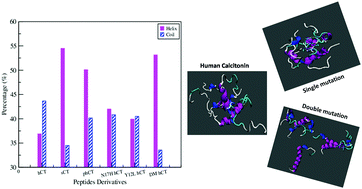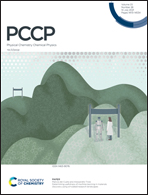Controlling the self-assembly of human calcitonin: a theoretical approach using molecular dynamics simulations†
Abstract
Human calcitonin (hCT) is a 32-residue amino acid poly-peptide hormone which is secreted by the C-cells (also known as parafollicular cells) of thyroid glands. It acts to inhibit osteoclast cell hormones by reducing the cell function and regulating calcium and phosphate in blood. hCT has a high tendency to assemble into protofilaments with β-sheet conformations. Amyloid fibril formation of hCT reduces its bio-activity and limits its application as a therapeutic drug. Salmon calcitonin (sCT), which also carries the same disulfide bridge at the N and C-terminus, but differs at the 16 residue position from hCT, has less propensity to aggregate than hCT. Human calcitonin has much higher bio-activity than sCT if its aggregation propensity is reduced. Substituting the key residues which are responsible for the aggregation of hCT, is one of the ways to reduce its aggregation and fibril formation. hCT analogues with less aggregation tendency can be exploited as therapeutic drugs. In this work, we study the amyloidogenic behavior of hCT and its peptide based derivatives i.e., sCT, phCT, N17H hCT, Y12L hCT and DM hCT, through classical molecular dynamics (MD) simulations. Our study reveals that sCT is the least aggregation prone derivative, and the double mutation at position 12 and 17 can reduce the aggregation propensity of this peptide. Also, we have applied these mutant variants of hCT as peptide inhibitors in the self-aggregation of hCT. This study could help in understanding and preparing peptide-based inhibitors for hCT fibrillation and their applications as therapeutic drugs.



 Please wait while we load your content...
Please wait while we load your content...